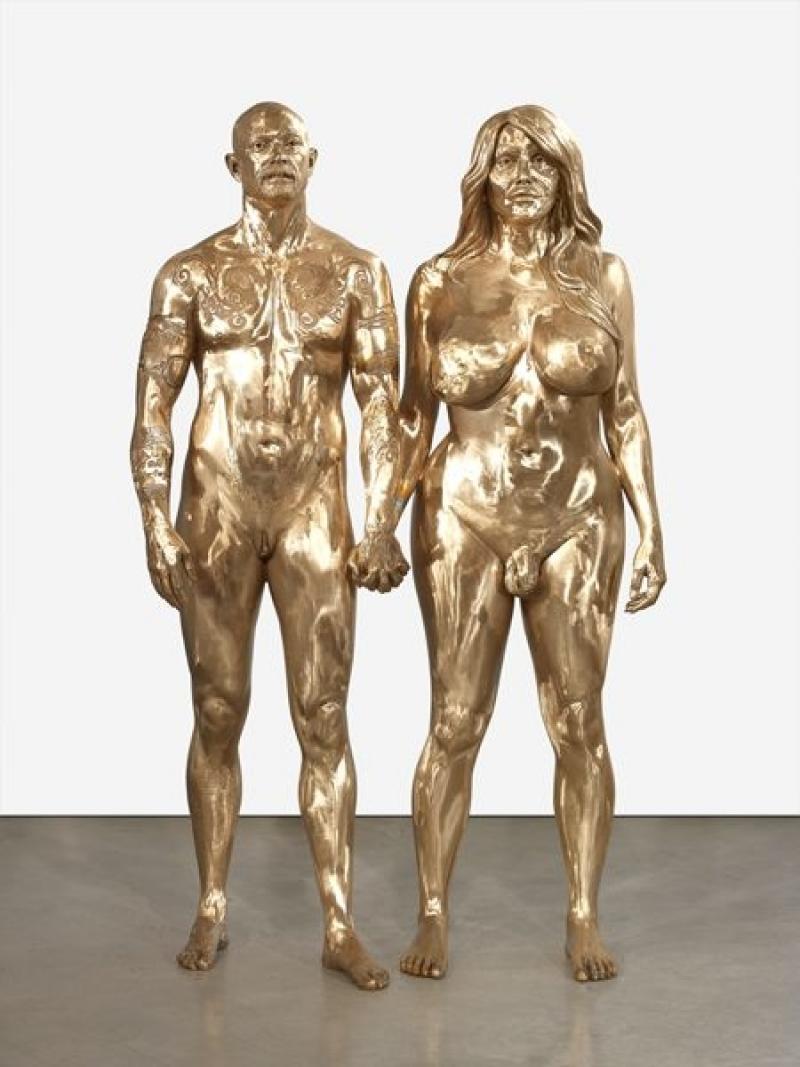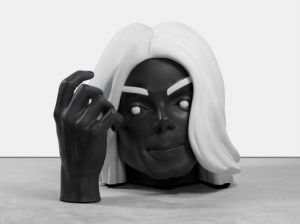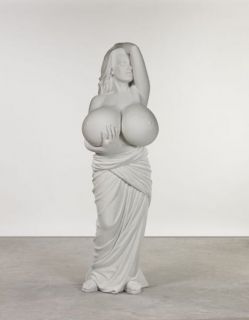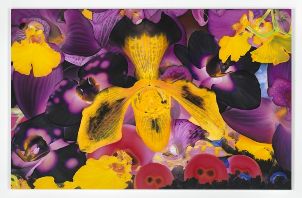Marc Quinn, White Cube | reviews, news & interviews
Marc Quinn, White Cube
Marc Quinn, White Cube
Popporn: pure mainstream commercial art makes a spectacle of itself

Marc Quinn is used to making a spectacle of himself. In Self (1991 and ongoing), a life-sized cast of his head was filled with his own blood. It was a stark and sobering reflection on what we all share, the universality of the most basic of human elements. But with the works in his new show Allanah, Buck, Catman, Chelsea, Michael, Pamela and Thomas, "spectacle" becomes the operative word, and universality is nowhere to be found.
In these sculptures, produced over the last two years, Quinn has chosen to produce portraits of people who have elected to undergo radical and repeated cosmetic surgery, hormone treatment, or tattooing and piercings. This work is no longer a look at what all humanity involuntarily shares, but rather what a certain infinitesimal section of the population has chosen to do to themselves.
 The Ecstatic Autogenesis of Pamela is a bronze of the television actress, silicone to the fore as she thrusts her breasts skywards. This is, perhaps, the acceptable face of cosmetic surgery, a woman who owes her career to artificial enhancement, but whose interventions now seem (at least in Hollywood) normative. One stage further down the road are two marble heads of Michael Jackson, Man in the Mirror and Man in the Mirror (Monochrome Reversal), one a white marble face, one black (pictured above right).
The Ecstatic Autogenesis of Pamela is a bronze of the television actress, silicone to the fore as she thrusts her breasts skywards. This is, perhaps, the acceptable face of cosmetic surgery, a woman who owes her career to artificial enhancement, but whose interventions now seem (at least in Hollywood) normative. One stage further down the road are two marble heads of Michael Jackson, Man in the Mirror and Man in the Mirror (Monochrome Reversal), one a white marble face, one black (pictured above right).
And then there are the extremes: a portrait of Chelsea Charms (pictured below), whose breasts, the press material finds it necessary to tell us, weigh 52 lbs. And Buck and Allanah, two porn stars who have undergone transgender surgery, but remain in a halfway state, having sex, Allanah's penis penetrating the male Buck’s vagina. Buck, in a separate piece, poses with cigar, tattoos and vagina; each of these appendages is presented as no more essential than the others: they seem all to be lifestyle choices. It doesn’t take a visit to Dr Freud to recognise a series of pathologies – sometimes a cigar is not just a smoke.
 My discussion has focused thus far on psychology, pathology and sexuality, not on the art, for, despite Quinn’s reliance on traditional materials and styles, the art is dull beyond imagining. It is competent, certainly, on a technical level, but it is also facile and bland in presentation, relying entirely on pathology to create interest. The two Michael Jackson pieces would look at home in Disneyland, or as balloons in the Thanksgiving Day parade down Fifth Avenue: they are pure mainstream commercial art.
My discussion has focused thus far on psychology, pathology and sexuality, not on the art, for, despite Quinn’s reliance on traditional materials and styles, the art is dull beyond imagining. It is competent, certainly, on a technical level, but it is also facile and bland in presentation, relying entirely on pathology to create interest. The two Michael Jackson pieces would look at home in Disneyland, or as balloons in the Thanksgiving Day parade down Fifth Avenue: they are pure mainstream commercial art.
Quinn, in a very obvious attempt to ward off the suggestion that he has created a 21st-century freak show, has stressed the agency of his models, suggesting that they are artists in their own right – outsider artists – who work on themselves instead of on canvas. He compares them to the embryo sculptures he produced a couple of years ago, and thinks "the transformation from embryo to fully grown adult is much more extreme than anything that any of the models have undergone". True, perhaps, but that change is both involuntary and universal. The same cannot be said for his models, who have not only been driven by their own psychodramas to these extremes, but are now reduced by the artist to a fetishised commodification of these psychodramas. Not an edifying spectacle.
 By contrast, Quinn has continued to make his lush, saturated flower paintings (Photoevaporation, pictured right), and they remain satisfyingly strange, neither one thing nor the other, finding an eerie no-man’s-land between photography and painting. On the walls of the White Cube, they manage to remain above the fray, on another level entirely from the sculptures they surround.
By contrast, Quinn has continued to make his lush, saturated flower paintings (Photoevaporation, pictured right), and they remain satisfyingly strange, neither one thing nor the other, finding an eerie no-man’s-land between photography and painting. On the walls of the White Cube, they manage to remain above the fray, on another level entirely from the sculptures they surround.
- Marc Quinn: Allanah, Buck, Catman, Chelsea, Michael, Pamela and Thomas at White Cube, Hoxton Square until 26 June
- All images by Roger Wooldridge, courtesy White Cube
Explore topics
Share this article
The future of Arts Journalism
You can stop theartsdesk.com closing!
We urgently need financing to survive. Our fundraising drive has thus far raised £49,000 but we need to reach £100,000 or we will be forced to close. Please contribute here: https://gofund.me/c3f6033d
And if you can forward this information to anyone who might assist, we’d be grateful.

Subscribe to theartsdesk.com
Thank you for continuing to read our work on theartsdesk.com. For unlimited access to every article in its entirety, including our archive of more than 15,000 pieces, we're asking for £5 per month or £40 per year. We feel it's a very good deal, and hope you do too.
To take a subscription now simply click here.
And if you're looking for that extra gift for a friend or family member, why not treat them to a theartsdesk.com gift subscription?
more Visual arts
 'We are bowled over!' Thank you for your messages of love and support
Much-appreciated words of commendation from readers and the cultural community
'We are bowled over!' Thank you for your messages of love and support
Much-appreciated words of commendation from readers and the cultural community
 Folkestone Triennial 2025 - landscape, seascape, art lovers' escape
Locally rooted festival brings home many but not all global concerns
Folkestone Triennial 2025 - landscape, seascape, art lovers' escape
Locally rooted festival brings home many but not all global concerns
 Sir Brian Clarke (1953-2025) - a personal tribute
Remembering an artist with a gift for the transcendent
Sir Brian Clarke (1953-2025) - a personal tribute
Remembering an artist with a gift for the transcendent
 Emily Kam Kngwarray, Tate Modern review - glimpses of another world
Pictures that are an affirmation of belonging
Emily Kam Kngwarray, Tate Modern review - glimpses of another world
Pictures that are an affirmation of belonging
 Kiefer / Van Gogh, Royal Academy review - a pairing of opposites
Small scale intensity meets large scale melodrama
Kiefer / Van Gogh, Royal Academy review - a pairing of opposites
Small scale intensity meets large scale melodrama
 Jenny Saville: The Anatomy of Painting, National Portrait Gallery review - a protégé losing her way
A brilliant painter in search of a worthwhile subject
Jenny Saville: The Anatomy of Painting, National Portrait Gallery review - a protégé losing her way
A brilliant painter in search of a worthwhile subject
 Abstract Erotic, Courtauld Gallery review - sculpture that is sensuous, funny and subversive
Testing the boundaries of good taste, and winning
Abstract Erotic, Courtauld Gallery review - sculpture that is sensuous, funny and subversive
Testing the boundaries of good taste, and winning
 Edward Burra, Tate Britain review - watercolour made mainstream
Social satire with a nasty bite
Edward Burra, Tate Britain review - watercolour made mainstream
Social satire with a nasty bite
 Ithell Colquhoun, Tate Britain review - revelations of a weird and wonderful world
Emanations from the unconscious
Ithell Colquhoun, Tate Britain review - revelations of a weird and wonderful world
Emanations from the unconscious
 Rachel Jones: Gated Canyons, Dulwich Picture Gallery review - teeth with a real bite
Mouths have never looked so good
Rachel Jones: Gated Canyons, Dulwich Picture Gallery review - teeth with a real bite
Mouths have never looked so good
 Yoshitomo Nara, Hayward Gallery review - sickeningly cute kids
How to make millions out of kitsch
Yoshitomo Nara, Hayward Gallery review - sickeningly cute kids
How to make millions out of kitsch
 Hamad Butt: Apprehensions, Whitechapel Gallery review - cool, calm and potentially lethal
The YBA who didn’t have time to become a household name
Hamad Butt: Apprehensions, Whitechapel Gallery review - cool, calm and potentially lethal
The YBA who didn’t have time to become a household name

Add comment